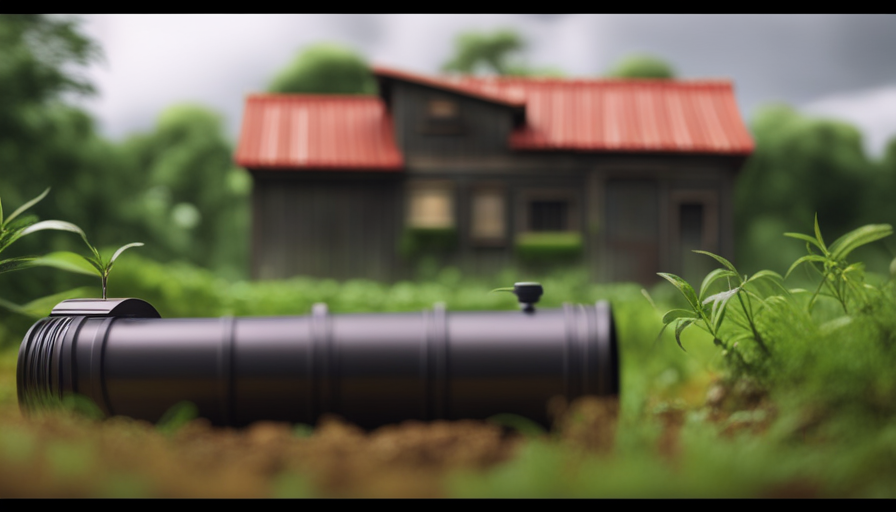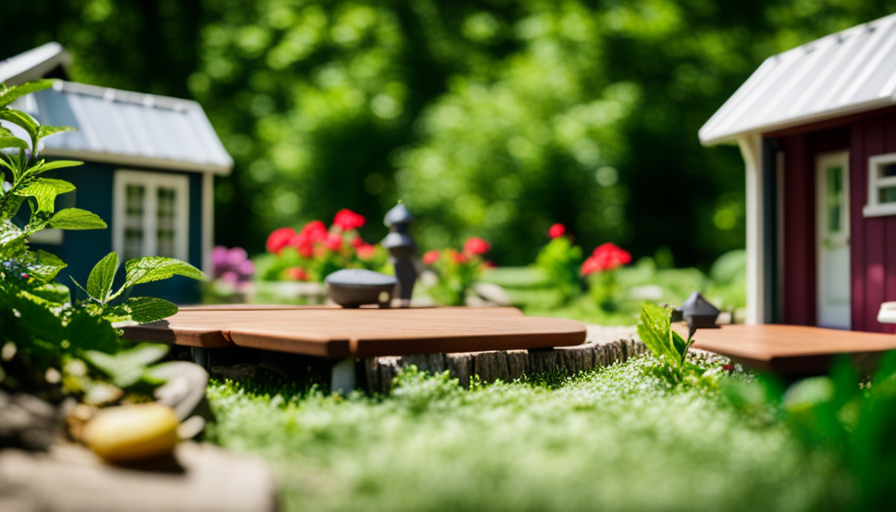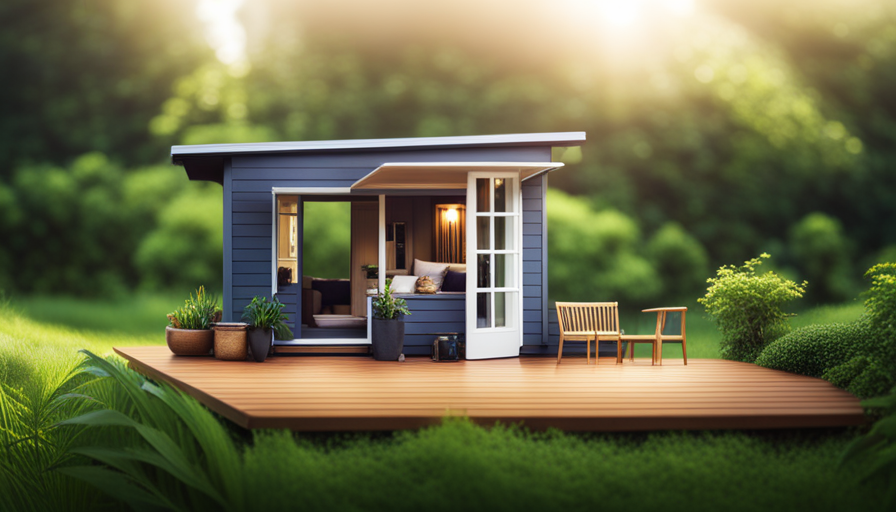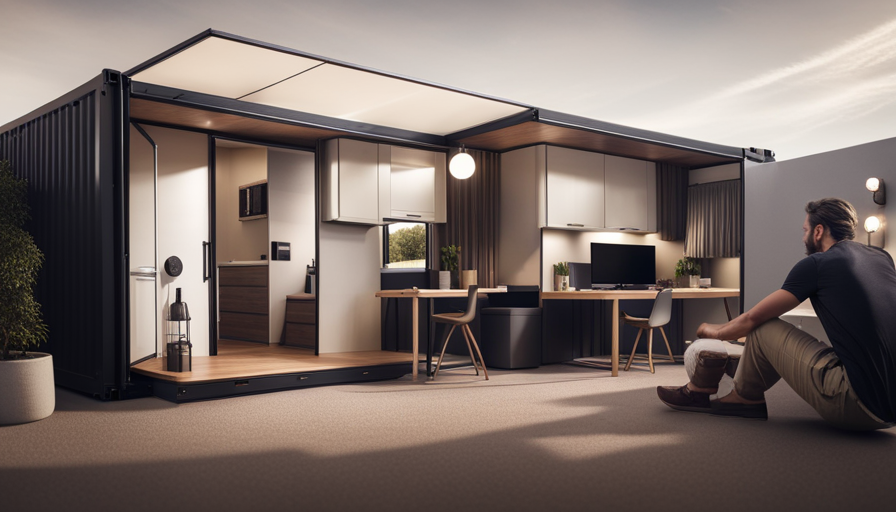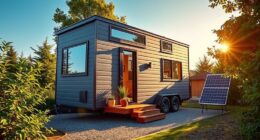Picture this situation: You are stranded in the middle of a vast desert, surrounded by endless sandy landscapes in every direction. The scorching sun beats down relentlessly, causing an overwhelming thirst. Just when you feel like all hope is lost, a small oasis appears in the distance, offering a glimmer of hope.
In a similar way, tiny houses have become oases of sustainability in a world plagued by environmental challenges. But how do these compact dwellings quench their thirst for water?
In this article, I will delve into the fascinating world of water systems for tiny houses. From collecting rainwater to utilizing natural water sources, we will explore the various innovative methods employed by tiny house owners to ensure a constant supply of water.
So, let’s embark on this journey and discover the hidden secrets of how these tiny houses get water.
Key Takeaways
- Tiny houses rely on water collection systems such as rainwater and groundwater.
- Water from these sources is filtered and treated for drinking and daily use.
- Portable water tanks are used for storage and distribution in tiny homes, allowing for easy transportation and connection to plumbing.
- Water conservation techniques, such as low-flow fixtures and rainwater harvesting, are important in reducing water consumption in tiny houses.
Water Collection Systems
Tiny houses rely on clever water collection systems to capture and store rainwater, allowing inhabitants to live sustainably and off-grid. These systems involve the installation of gutters and downspouts on the roof, which direct the rainwater into storage tanks.
The collected rainwater is then filtered and treated to make it safe for drinking and daily use. Additionally, some tiny houses utilize underground wells to access groundwater for their water needs. These wells are typically drilled deep into the ground to tap into a natural aquifer.
The water from these wells is also filtered and treated before it is used. By utilizing rainwater and underground wells, tiny houses are able to reduce their reliance on traditional water sources and minimize their impact on the environment.
This water collection system is just one step towards utilizing natural water sources for a sustainable and self-sufficient lifestyle.
Utilizing Natural Water Sources
Utilizing natural water sources in your tiny home is essential for maintaining a sustainable and eco-friendly lifestyle. There are several methods to ensure a constant supply of clean water.
- Water desalination: By utilizing the process of desalination, you can convert saltwater into freshwater suitable for drinking and household use. This can be done through reverse osmosis or distillation techniques.
- Rainwater harvesting: Collecting rainwater is another effective way to obtain water for your tiny house. By installing a rainwater collection system, you can capture and store rainwater for various purposes such as flushing toilets, watering plants, and even showering.
- Utilizing natural springs: If your tiny house is located near a natural spring, you can tap into this natural water source. However, it’s important to ensure the water is safe for consumption by testing it regularly for contaminants.
- Groundwater wells: Digging a well on your property allows you to access groundwater. This requires professional assistance to ensure proper drilling and installation.
In the next section, we’ll explore the use of portable water tanks for storing and distributing water in tiny homes.
Portable Water Tanks
To ensure a constant supply of water in your sustainable lifestyle, you can incorporate portable water tanks for storage and distribution. These tanks are designed to be easily transportable and can hold a significant amount of water, ranging from a few gallons to several hundred gallons. Portable water tanks are made from durable materials such as polyethylene, which ensures they are lightweight and resistant to corrosion. Additionally, they often come with built-in handles or wheels for easy maneuvering. When it comes to water transportation options, portable water tanks can be easily filled at various locations, such as public water sources or natural water bodies. They can then be transported to your tiny house and connected to the plumbing system for convenient access to water. By utilizing portable water storage, you can ensure a reliable water supply for your tiny house without relying solely on traditional infrastructure. Transitioning into the subsequent section about ‘water delivery services,’ you can also explore alternative methods to obtain water.
Water Delivery Services
If you’re looking for a convenient way to ensure a steady water supply for your sustainable lifestyle, consider checking out water delivery services. These services provide a reliable solution for tiny house owners who want to conserve water while still meeting their daily needs. By utilizing water delivery services, you can have fresh water delivered directly to your tiny house, eliminating the need for a permanent water connection.
These services often offer options for different water quantities and frequencies of delivery, allowing you to customize your water supply based on your unique needs. Additionally, water delivery services can provide an opportunity to learn about and implement water conservation techniques, such as rainwater harvesting or greywater recycling.
Transitioning into the subsequent section about filtration and purification systems, it’s important to ensure that the water delivered is safe and clean for consumption.
Filtration and Purification Systems
When it comes to ensuring safe and clean water for consumption in a tiny house, there are key points to consider.
First, installing water filters is crucial for removing impurities and contaminants from the water source.
Second, UV or chemical purification methods can be employed to further disinfect the water and eliminate any remaining bacteria or viruses.
Overall, implementing a comprehensive filtration and purification system is essential for maintaining a healthy water supply in a tiny house.
Installing water filters
Installing water filters in tiny houses can greatly improve the quality of the water supply, with studies showing that a well-maintained filter can remove up to 99% of contaminants. There are various water filtration methods available for tiny houses, each with its own benefits. One common method is activated carbon filtration, which effectively removes chlorine, sediment, and organic compounds. Another option is reverse osmosis filtration, which uses a semipermeable membrane to remove impurities like heavy metals and bacteria. Additionally, ceramic filters are useful in trapping bacteria and parasites. To provide a visual representation of these filtration methods, the table below outlines their key features and benefits:
| Filtration Method | Key Features | Benefits |
|---|---|---|
| Activated Carbon | Removes chlorine, sediment, and organic compounds | Improves taste and odor of water |
| Reverse Osmosis | Removes heavy metals and bacteria | Produces high-quality drinking water |
| Ceramic | Traps bacteria and parasites | Provides safe drinking water |
In the next section, we will discuss the use of UV or chemical purification methods.
Using UV or chemical purification methods
UV or chemical purification methods are alternative options for ensuring the safety and cleanliness of your water supply. When it comes to purifying water in tiny houses, two popular methods are UV purification and chemical purification.
UV purification uses ultraviolet light to destroy harmful microorganisms and pathogens in the water, making it safe to drink. It is effective in killing bacteria, viruses, and parasites, but it does not remove chemical contaminants.
On the other hand, chemical purification involves using chemicals such as chlorine or iodine to kill bacteria and viruses. It is effective in removing a wide range of contaminants, including chemical pollutants. However, it may leave a residual taste and odor in the water.
When comparing effectiveness and sustainability, UV purification is more effective in killing microorganisms, while chemical purification is more sustainable in terms of removing chemical contaminants. Both methods have their advantages and disadvantages, so it’s important to choose the one that best suits your needs.
Ensuring safe and clean water for consumption is crucial for maintaining good health and well-being.
Ensuring safe and clean water for consumption
When it comes to ensuring safe and clean water for consumption in tiny houses, there are several important considerations. One of the key aspects is water contamination prevention, which involves implementing effective water testing methods. By regularly testing the water for contaminants such as bacteria, viruses, and chemicals, we can identify any potential risks and take appropriate measures to address them. This is crucial for maintaining the health and well-being of the occupants in a tiny house.
To emphasize the importance of water testing, I have created a table below that highlights some common waterborne contaminants and their potential health effects:
| Contaminant | Health Effects |
|---|---|
| Bacteria | Gastrointestinal illnesses, diarrhea |
| Viruses | Respiratory and gastrointestinal illnesses |
| Chemicals | Neurological and developmental disorders |
By understanding the potential risks and implementing effective water testing methods, we can ensure that the water in tiny houses is safe for consumption. Now, let’s move on to discussing another critical aspect of tiny house living: composting toilets and greywater systems.
Composting Toilets and Greywater Systems
Composting toilets are an excellent option for reducing water usage in tiny houses. They work by breaking down human waste into compost, which can later be used as fertilizer for plants. By using composting toilets, I’m able to conserve water and contribute to a more sustainable lifestyle.
Another key point in wastewater management for tiny houses is the collection and treatment of greywater. Greywater refers to the wastewater generated from activities such as washing dishes, showering, and doing laundry. By collecting and treating greywater, I’m able to reuse it for purposes such as irrigation or flushing toilets, reducing the strain on freshwater resources.
Implementing eco-friendly wastewater management systems is crucial for sustainable living in tiny houses. This can include various strategies such as installing rainwater harvesting systems, using natural filtration methods, and utilizing biodegradable cleaning products. By adopting these practices, I’m able to minimize my environmental impact and create a more self-sufficient and eco-friendly living space.
Using composting toilets to reduce water usage
One interesting statistic is that tiny houses using composting toilets can reduce water usage by up to 90%. This is a significant advantage for those looking to live a sustainable lifestyle with minimal environmental impact.
Here are five reasons why composting toilets are excellent waterless bathroom options:
- No need for flushing: With a composting toilet, there’s no need for water to flush waste away, saving gallons of water each day.
- Natural decomposition: Composting toilets utilize natural processes to break down waste into compost, reducing the need for water-intensive sewage treatment plants.
- Odor control: These toilets are designed to minimize odors through proper ventilation and the addition of carbon-rich materials like sawdust or coconut coir.
- Nutrient-rich compost: The resulting compost can be used as a valuable fertilizer for plants, closing the nutrient loop and reducing the need for synthetic fertilizers.
- Versatility: Composting toilets can be installed in any location, making them suitable for off-grid living or areas with limited access to water and sewage systems.
Transitioning into the subsequent section about collecting and treating greywater for reuse, it’s important to consider other ways tiny houses can minimize their water usage.
Collecting and treating greywater for reuse
To maximize your water conservation efforts, consider collecting and treating greywater for reuse in your sustainable lifestyle journey. Greywater refers to the wastewater generated from activities such as washing dishes, doing laundry, and taking showers. By capturing and treating greywater, you can significantly reduce your reliance on fresh water sources.
One method of collecting greywater is by installing a separate plumbing system that diverts the water from showers, sinks, and washing machines to an outdoor storage tank. This collected greywater can then be treated using a filtration system to remove impurities and contaminants.
Additionally, you can also collect rainwater by installing a rain barrel or a larger rainwater harvesting system. By incorporating these methods, you can effectively reduce your water consumption and decrease your environmental impact.
Moving forward, implementing eco-friendly wastewater management systems will further enhance your water conservation efforts.
Implementing eco-friendly wastewater management systems
By incorporating eco-friendly wastewater management systems, you’ll be amazed at the significant impact you can make on conserving water and protecting the environment. Here are three powerful ways to achieve this:
- Composting for gardening: Instead of wasting valuable nutrients by flushing them down the drain, you can compost your food scraps and use the resulting organic matter to enrich your garden soil. This not only reduces the need for synthetic fertilizers but also minimizes the amount of wastewater generated.
- Rainwater harvesting: Capturing and storing rainwater allows you to utilize this free and abundant resource for various purposes, such as flushing toilets or watering plants. By reducing your reliance on municipal water supplies, you not only conserve water but also alleviate the strain on local water sources.
- Implementing water-efficient fixtures: Installing low-flow toilets, faucets, and showerheads can significantly reduce water consumption without sacrificing comfort or functionality. These fixtures use innovative technologies to maintain high performance while minimizing water usage.
By implementing these eco-friendly wastewater management systems, you can take a proactive approach to water conservation, which will be further explored in the subsequent section on water conservation techniques.
Water Conservation Techniques
When it comes to water conservation in a tiny house, there are several key points to consider.
First, installing low-flow faucets and showerheads can significantly reduce water usage without sacrificing functionality.
Secondly, implementing water-saving practices such as turning off the tap while brushing teeth or collecting rainwater for gardening can further minimize water waste.
Lastly, monitoring and reducing water usage by regularly checking for leaks and being mindful of how water is being used on a daily basis is crucial for sustainable living in a tiny house.
Installing low-flow faucets and showerheads
Get ready to save water in your tiny house by installing low-flow faucets and showerheads! Here are four key benefits of using low-flow faucets and water-efficient showerheads:
- Reduced water consumption: Low-flow faucets and showerheads are designed to limit water flow without compromising performance. This means you can enjoy the same level of comfort while significantly reducing your water usage.
- Energy savings: Using less water also translates into energy savings since less energy is required to heat the water. This can lead to lower utility bills and a smaller environmental footprint.
- Cost-effective: With reduced water consumption, you can expect to see a decrease in your water bills, making low-flow fixtures a cost-effective choice in the long run.
- Environmentally friendly: By conserving water, you’re contributing to the preservation of this precious resource and reducing the strain on local water sources.
Now that you’ve installed low-flow faucets and showerheads, let’s move on to implementing other water-saving practices.
Implementing water-saving practices
To further enhance water conservation in tiny houses, not only should low-flow faucets and showerheads be installed, but water-saving practices should also be implemented. These practices involve adopting water-saving techniques and using water-efficient appliances. By employing these strategies, tiny house dwellers can significantly reduce their overall water consumption.
Water-saving techniques include capturing rainwater for non-potable use, such as watering plants and flushing toilets. Additionally, graywater systems can be installed to recycle water from sinks, showers, and laundry for irrigation purposes. These measures help minimize water waste and ensure sustainable usage within the limited space of a tiny house.
Furthermore, selecting water-efficient appliances like dishwashers and washing machines is crucial. These appliances are designed to use less water while still providing optimal performance. By integrating these water-saving practices and using water-efficient appliances, tiny house owners can maximize their water efficiency and minimize their ecological footprint.
Transitioning into the subsequent section on monitoring and reducing water usage, it’s important to continuously evaluate and adjust water consumption habits to further optimize resource preservation.
Monitoring and reducing water usage
Keep an eye on your water usage like a hawk and make every drop count by implementing efficient habits and making necessary adjustments. To effectively monitor water usage in a tiny house, consider the following water conservation techniques:
- Install water meters: Keep track of your daily water consumption by installing meters on all water sources, including showers, faucets, and toilets. This enables you to identify any excessive or wasteful water usage.
- Regularly check for leaks: Even the tiniest leaks can lead to significant water wastage over time. Conduct routine inspections to identify and fix any leaks promptly.
- Utilize water-saving fixtures: Install low-flow faucets, showerheads, and toilets that are specifically designed to minimize water usage without compromising functionality.
By diligently monitoring water usage and implementing these conservation techniques, you can significantly reduce water consumption in your tiny house. Transitioning into the subsequent section about off-grid water solutions, it’s important to explore alternative methods of sourcing water in remote locations.
Off-Grid Water Solutions
Imagine living in a tiny house and relying on off-grid water solutions to meet your daily needs. Off-grid water purification and rainwater harvesting are two common methods used in tiny houses to ensure a sustainable water supply. Off-grid water purification systems, such as UV filters or ceramic filters, remove impurities and make water safe for consumption. Rainwater harvesting involves collecting rainwater from the roof into storage tanks, which can then be used for various purposes like cooking, cleaning, and even showering. It is important to monitor water usage in tiny houses to ensure efficient use and avoid wastage. To give you a better idea, here is a table showcasing the average water usage for different activities in a tiny house:
| Activity | Average Water Usage |
|---|---|
| Showering | 2-5 gallons |
| Cooking | 1-2 gallons |
| Washing dishes | 1-3 gallons |
Transitioning to the subsequent section about community water sources, it is essential for tiny house dwellers to explore alternative water sources to supplement their off-grid solutions.
Community Water Sources
Living in a tiny house means relying on alternative water sources from the community to supplement off-grid solutions. When it comes to obtaining water, tiny house dwellers often turn to community initiatives and water conservation efforts.
Here are three ways tiny house owners can access water from their community:
- Rainwater collection systems: Many communities have implemented rainwater harvesting programs that allow residents to collect rainwater and use it for various purposes, including drinking, cooking, and bathing.
- Shared wells: Some communities have established shared wells that provide water to multiple tiny houses. This allows residents to access a reliable and sustainable water source while minimizing their individual environmental impact.
- Public water stations: In certain areas, public water stations are available for tiny house residents to fill their water tanks. These stations are equipped with filtered water and are a convenient option for those who need to refill their water supply.
Moving forward to the next section about ‘alternative water sources,’ let’s explore additional options for obtaining water off-grid.
Alternative Water Sources
While exploring alternative water sources, it’s fascinating to discover that some off-grid enthusiasts have tapped into the creative idea of collecting water from the air using atmospheric water generators, which work like magical machines that turn humidity into a liquid oasis. These generators utilize a process known as water desalination, where the moisture in the air is condensed and purified to create clean drinking water. Another popular method for obtaining water in tiny houses is through rainwater harvesting. This involves collecting rainwater from roofs or other surfaces and storing it in tanks or barrels for later use. To give you a visual representation, here’s a table showcasing the pros and cons of these alternative water sources:
| Alternative Water Sources | Pros | Cons |
|---|---|---|
| Atmospheric Water Generators | – No need for external water sources – Provides clean drinking water | – Requires electricity – Limited water production |
| Rainwater Harvesting | – Utilizes natural resource – Reduces demand on community water sources | – Requires storage infrastructure – Dependent on rainfall |
By utilizing these alternative water sources, tiny house dwellers can become self-sufficient and reduce their environmental impact.
Frequently Asked Questions
What are the benefits of using a portable water tank for a tiny house?
Using a portable water tank for a tiny house offers numerous benefits. Firstly, the installation process is straightforward and can be done without professional help, reducing the overall cost of setup. Additionally, portable water tanks are designed to be compact and lightweight, making them easy to transport. They provide a reliable and convenient source of water for daily needs such as cooking, cleaning, and bathing.
Overall, a portable water tank is a practical and cost-effective solution for ensuring a steady water supply in a tiny house.
How can I ensure the water I collect from natural sources is safe to use?
To ensure the water collected from safe water sources is safe to use, various water purification methods can be employed. These methods include filtration, disinfection, and chemical treatments. Filtration removes impurities and particles, while disinfection kills harmful microorganisms. Chemical treatments, such as chlorination, can also be used to purify the water.
It’s important to regularly test the water quality and maintain the purification system to ensure the water remains safe for consumption and use.
Are there any regulations or permits required for installing a water collection system in a tiny house?
To ensure the safety of using collected rainwater in a tiny house, it’s important to be aware of potential health risks. Contaminants like bacteria, viruses, and chemicals can be present in rainwater. It’s crucial to properly filter and treat the water before use.
Regarding permits, regulations for installing a water collection system in a tiny house vary depending on location. Contacting the local building department or health department is necessary to determine the specific requirements and obtain the necessary permit.
Are there any specific maintenance tasks or considerations for composting toilets and greywater systems in a tiny house?
When it comes to maintaining composting toilets in a tiny house, one must engage in a delightful routine of regular maintenance. Embrace the joy of emptying and cleaning the composting bin, ensuring proper ventilation, and monitoring the moisture levels.
As for greywater systems, it’s crucial to remember the importance of regular cleaning and maintenance to prevent any unpleasant odors or clogs. Regularly inspect and clean filters, pipes, and storage tanks to ensure optimal functionality.
Can you provide some examples of water conservation techniques that are particularly effective for tiny houses?
When it comes to water conservation techniques for tiny houses, rainwater harvesting and water filtration are particularly effective.
Rainwater harvesting involves collecting rainwater from the roof and storing it in a tank for later use. This water can be filtered using a water filtration system to remove impurities and make it suitable for various purposes like drinking, cooking, and bathing.
These techniques help maximize the use of available water resources and minimize water waste in a tiny house.
Conclusion
In conclusion, when it comes to tiny houses, water can be obtained through various methods. Water collection systems, such as rainwater harvesting, prove to be efficient and eco-friendly. Utilizing natural sources like rivers or lakes can be a viable option for those located near such water bodies. Portable water tanks are useful for those on the move or with limited space. Water delivery services ensure a constant supply, while filtration and purification systems guarantee safe and clean water. By practicing water conservation techniques, tiny house owners can further optimize their water usage.
Off-grid water solutions allow for self-sufficiency, and community water sources provide a collective approach. Lastly, alternative water sources, such as wells or springs, offer alternative options. Just like a tiny house ingeniously maximizes limited space, these water solutions ingeniously ensure a sustainable and thriving water supply.
I’m Theodore, and I love tiny houses. In fact, I’m the author of Tiny House 43, a book about tiny houses that are also tree houses. I think they’re magical places where imaginations can run wild and adventures are just waiting to happen.
While tree houses are often associated with childhood, they can be the perfect adult retreat. They offer a cozy space to relax and unwind, surrounded by nature. And since they’re typically built on stilts or raised platforms, they offer stunning views that traditional homes simply can’t match.
If you’re looking for a unique and romantic getaway, a tree house tiny house might just be the perfect option.
